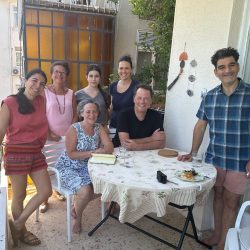This summer, we’re writing a series of blog posts dedicated to sharing the Bakehouse’s recent trip to Turkey to explore the country’s rich culinary traditions with a special focus on Sephardic Jewish cuisine. Leading us on this culinary journey are Bakehouse Managing Partner, Amy Emberling, and Hazim Tugun, the Bakehouse’s Bread Baker extraordinaire, who also lends his hands at the Bakehouse as a miller, bread recipe developer, teacher, and writer. Thus far, we’ve covered Amy’s return to Istanbul after a 36-year hiatus. For the second installment of the series, Amy and Hazim begin their culinary tour of Turkey in the Istanbul neighborhood of Kurtuluş, where they spent a most flavorful day.
For our first day of exploration in Turkey, we decided to start with a slightly broader lens of Turkish foodways than our very focused interest in Sephardic food. We engaged with the group Culinary Backstreets and booked a private food tour in a neighborhood of Istanbul called Kurtuluş–definitely off the usual tourist itinerary. Food in Kurtuluş is Turkish and also food of minority groups in Turkey—Armenians, Greeks, and Jews—who make Kurtuluş their home. We started at 9 am and had our last taste (some delicious ice cream) at 4 pm! It was a marathon of flavors, textures, history, and culture.
The morning started with some unexpected exercise, which isn’t a terrible thing before a food tour. The walk from our hotel to the beginning of the tour was supposed to be 30 minutes but of course there wasn’t any indication of the topography and it turned out to be a hilly route–between the hills and the nearby water, Istanbul looks a bit like San Francisco. Adding to the fun was that at 8:30 am it was already in the 80s with very high humidity. The final section of our walk was a massive, steep hill.
At the bottom of the hill I asked my husband Geoff, who was navigating, where our next turn was, hoping it was only part way up the hill, and he said, “At the top.” We put our heads down and climbed. We arrived at our destination, dripping with sweat, to meet our guide Uğur (the “g” with a curve over it in Turkish is a soft g, so his name is pronounced with a long U, “Ur”). Uğur was amused and fortunately so were we.
While we waited for my colleague Hazim, his wife Tarisa, and daughter Dilara, we quickly connected. I relish the openness that travelling affords us. My experience is that people know that they have a short time together, may never see each other again, and so often share lavishly and quickly. Uğur actually lived in the United States for about 9 years. He had gone to college in southern Oregon with his siblings, and after studying, they expanded the family textile business to the United States. His brother stayed to run the business and Uğur decided to return to Turkey, where he became a tourist guide.
In many countries that have extensive historical sites, guiding is a well regulated profession. They have rigorous courses of study and guides must meet official requirements to lead groups. Uğur added to his undergraduate degree in business with a university level course in guiding. He actually went to school with a woman we will meet with later in our trip, when we get to Izmir. We were in good hands with someone who understood where we were coming from, what we were looking for, and could help us translate what we were experiencing.
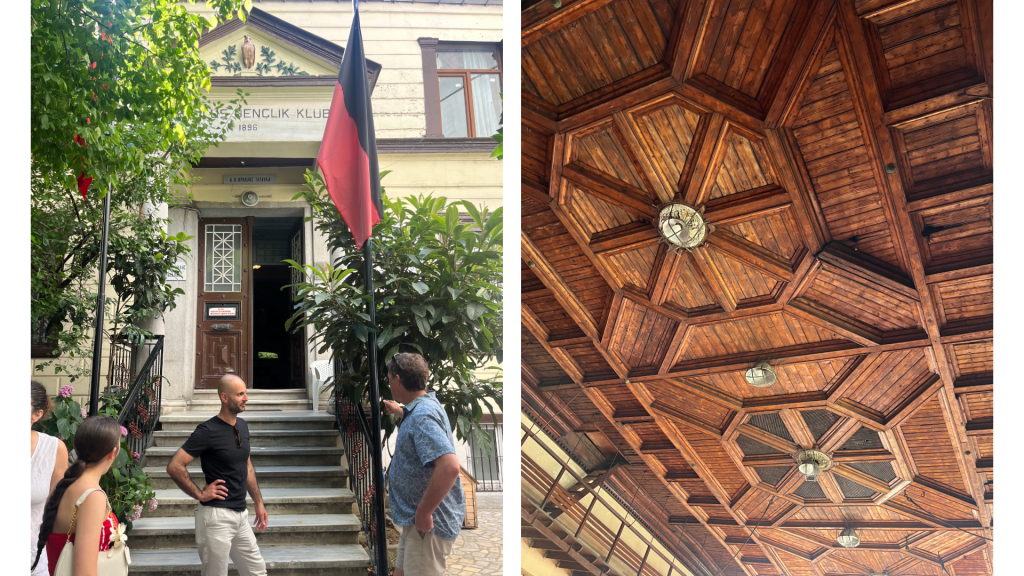
Our first stop was to enjoy a classic Turkish breakfast together. Uğur had set up an al fresco dining experience for us in the courtyard of what had been a vibrant Christian athletic club. He showed us around the building, full of team photos and trophies, and we saw the original basketball court which had an ornate wood ceiling. Today the club plays the important role of organizing youth sports in the neighborhood. Uğur had gathered the makings of breakfast and set a table for us under shade trees.
Turkish breakfasts can include cheeses, olives, platters of fresh vegetables always including tomatoes and cucumbers, bread, perhaps a börek (a savory pastry made from yufka dough, similar to filo, and filled many different things like cheese, spinach, potatoes, and formed in a variety of shapes) of some kind, fruit, yoghurt and tea and coffee. Our breakfast was made particularly special with kaymak drizzled with honey.
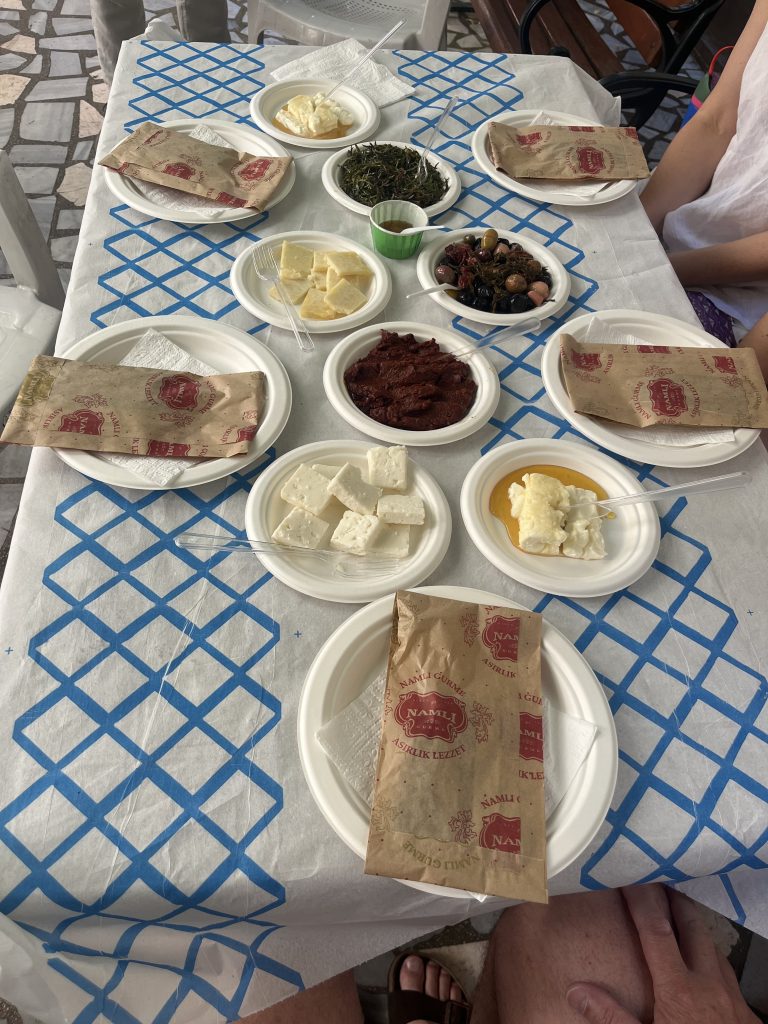
I had forgotten about kaymak since my last trip to Turkey 36 years ago! How could I have forgotten kaymak? It is so incredible. When my husband and I were on the excavation in Turkey, I occasionally baked for the team. I made carrot cake one day iced with sweetened kaymak for a local version of cream cheese frosting. Kaymak is the Turkish cousin to what some of us know as clotted cream. It is lightly fermented cream of buffalo milk. The texture is smooth and rich, firmer than the clotted cream that I’ve had. It is usually served as a square piece and can be cut with a butter knife. It is often served drizzled with honey. Later in this trip, we are taught to dip baklava in it, an unbelievably decadent move. It reminds me of something I’d do only when no one is looking.
Cheese is definitely a category of its own in Turkey. During our week we most frequently encountered a type of cheese called tulum peyniri, which can be served in different forms and used in many different ways. At our breakfast it was served on its own, to be enjoyed with bread and fresh vegetables. It’s a mix of raw cow, sheep, or goat milk fermented in goatskin. In cheese shops, it is often displayed in its furry container! It has a cheesy, earthy, slightly sour flavor.
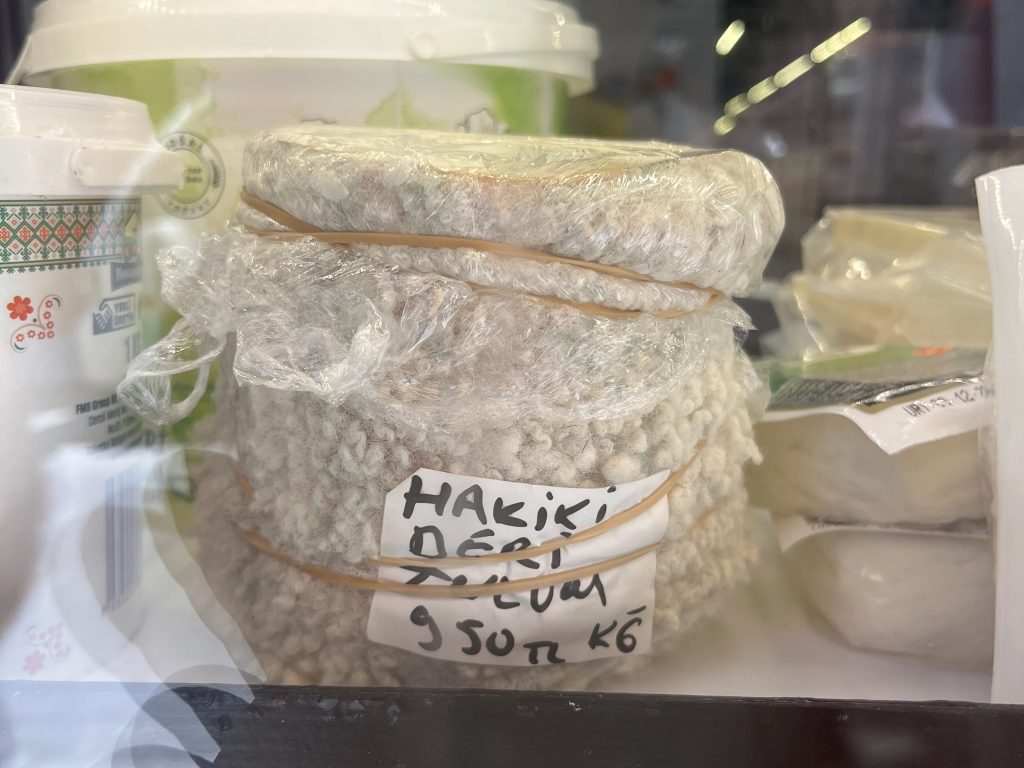
After our breakfast in Kurtuluş, and in keeping with exploring a neighborhood of minorities, we stopped in at Madam Despina, which was the first woman-owned meyhane (tavern) in Istanbul. Despina had passed but the restaurant continues. Here we had our first conversation about artichokes. They are a popular vegetable currently in season, and lucky Turkish cooks can buy them already prepped for cooking; leaves and choke removed. If you’ve ever prepared artichoke hearts you’ll know why I’m so excited by seeing them ready to cook.
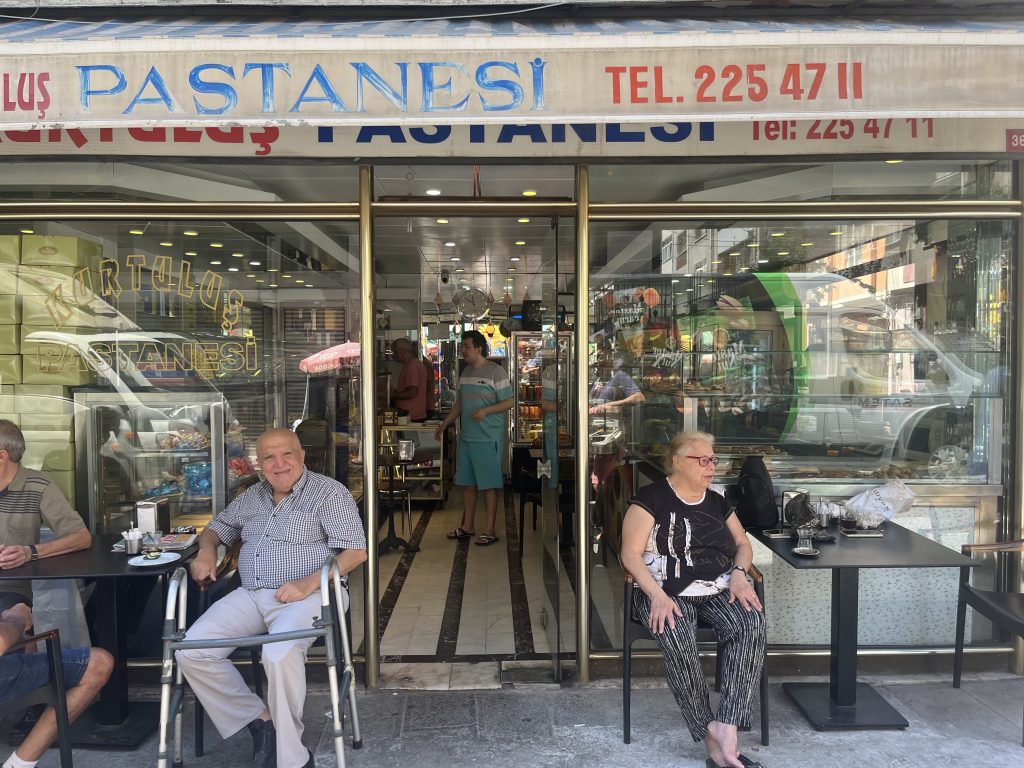
We moved on to a bakery, Kurtuluş Pastanesi. It serves Turkish baked goods and also caters to the local Jewish community. The Jewish community is down to somewhere between 10-14,000 people in Istanbul and many of the women who had baked for Jewish holidays and occasions are aging. They are happy to have someone else do the baking. This bakery has two kitchens, one is completely kosher so that their customers, 70% of which are Jewish, can enjoy all of their food. The most common Sephardic Jewish pastry that we came across is called börekitas. They are a small, two bite, crescent-moon shaped pastry (think empanada) stuffed most commonly with either roasted eggplant or potato. Hazim and I had read about them and we were thrilled to finally meet them at Kurtuluş Pastanesi.
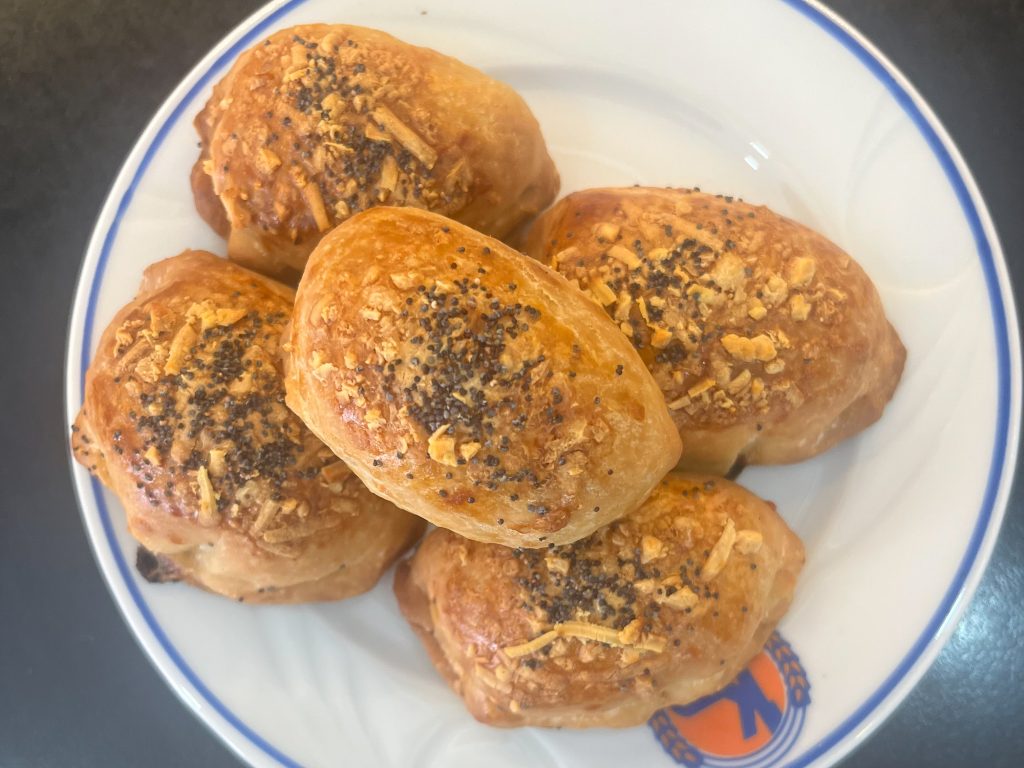
We spotted a tray of candied orange peel in one of the display cases, made mainly for Passover but also for other special occasions. Mosaik pasta (chocolate mosaic cake) is a dessert equally beloved in the Turkish and Jewish communities and Kurtuluş Pastanesi had its version on display. It’s a no-bake cake that combines melted chocolate with pieces of cookie and often nuts. There is a French version, which is rolled to look like a salami and slices are the common serving. The Turkish version is often in the form of a triangle and they now make it with many different flavor combinations. Coincidentally, we will be making this in our Fancy Schmancy Holiday Cookie Class this year. Now we’ll have some interesting history to add to the class.
On we went, so much to see that there was no time for lingering.
For something entirely different, we visited a small neighborhood restaurant serving food from Erzincan (the letter “c” in Turkish is pronounced like a “j”). Before sitting down to eat we watched three women making lavash (flatbread) in the back of the restaurant. They had a large tub of dough and were starting the process by rolling portions into balls and setting them down to rest. After it rested, they would use rolling pins to create the long oval breads ready for the oven.
Uğur shared that they had bought a machine to help them with the rolling but after using it for a week or so they abandoned it. They preferred their own handy work with the rolling pins. Hazim and I could relate. Machines often seem like a good solution. Sometimes they actually add to the work and don’t make the food as we’d like it. Some experiences are international!
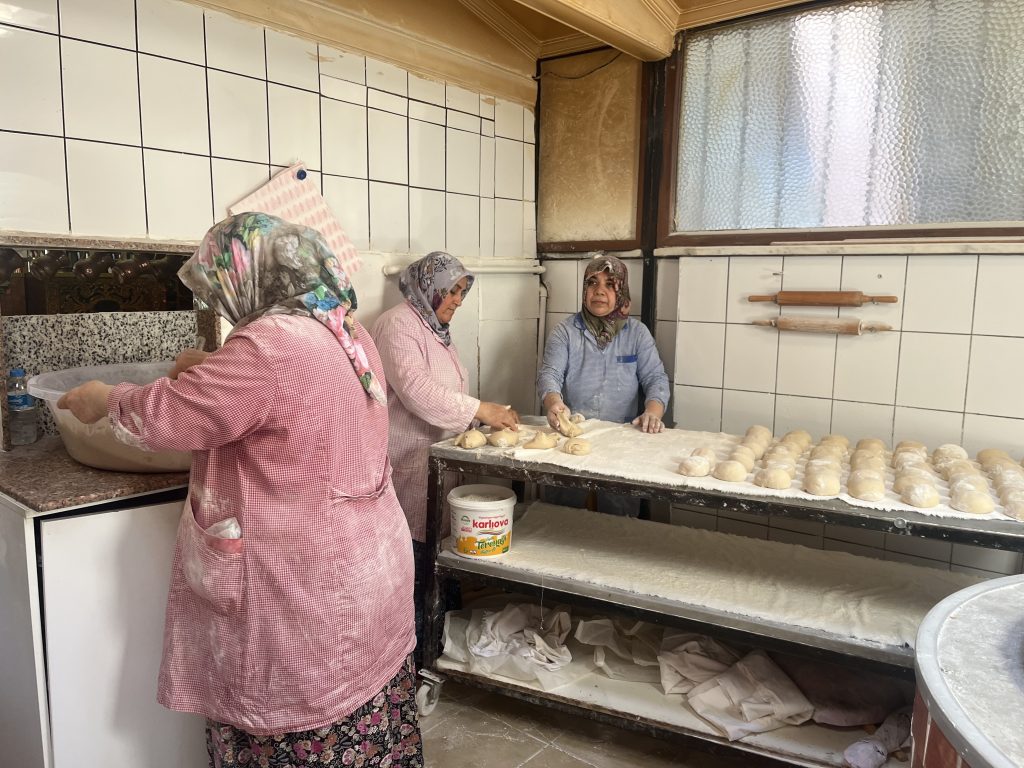
Lunch introduced us to two new dishes. We enjoyed the Turkish version of shakshuka called menemen, which is soft scrambled eggs with peppers, tomatoes, and onions (not the version with eggs poached in braised peppers and tomatoes that some of you may be familiar with). One of the joys of food travelling for me is seeing how foodways evolve and change over large geographic areas. National borders don’t stand a chance against the power of food! And then we enjoyed super tender bits of warm, salted, preserved beef called kavurma. It was fantastic tucked into our warm pieces of lavash.
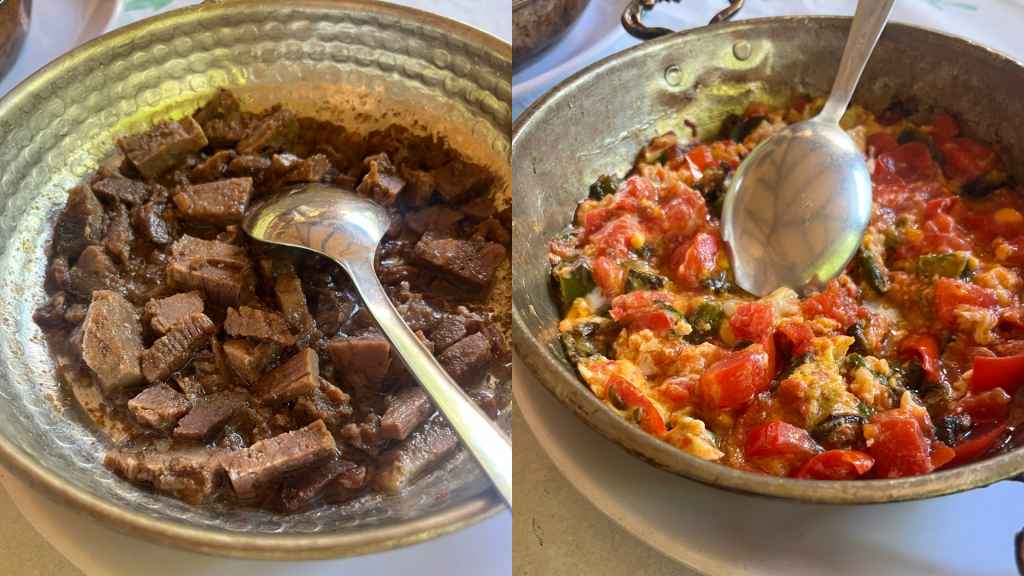
We had two more stops to go! One was a quick dip into a bakery which specializes in Greek Easter bread flavored with mastic, which is resin from the mastic tree and has a distinctive pine flavor. We had made this bread once years ago at the bakery, so it was interesting to see it made by masters. Mastic is a common flavor choice in some Turkish breads, ice cream, and candies. The bread had a subtle mastic flavor and a texture very similar to our egg challah.
Okay, in case we hadn’t had enough, we stopped for dondurma (ice cream). Ice cream shops and carts can be found all over Turkey. They offer wonderful fresh fruit flavors, chocolate, and many nut versions. Mastic ice cream is also a thing! What many of us will notice right away is the extensible texture of the ice cream. It stretches! And even when it’s super hot outside, the ice cream doesn’t melt easily. Why? It’s made with the starch from orchid tubers.This starchy powder is called sahlab. It’s also used in a winter beverage and has its origin in the Byzantine empire. I had this ice cream many years ago in Syria, before the internet, and had always wondered about it. Mystery solved!
A full day of exploration, tasting, and socializing for sure. Then we happily hopped on the metro back to our hotel for a cool shower and a late afternoon nap.
Tomorrow we meet up with Lian Penso and begin our exploration of Jewish Sephardic food on the Princes’ Islands of Burgazada and Buyukada.
Hungry for more?
- Read about Amy’s arrival in Istanbul and the reasons this trip came to be in our first post of the series.
She has been an avid food lover and baker since her childhood in Nova Scotia, Canada. After high school Amy moved to Cambridge, MA and received her bachelor’s degree from Harvard University. She then followed her passion for food and learned to cook and bake at L’ecole de Gastronomie Francaise at the Ritz Hotel in Paris, France as well as in Michigan restaurants. In 1999 she received her MBA from Columbia University.
Amy came to Zingerman’s Bakehouse when it opened in 1992 as one of the original bakers on the staff of eight. She soon became the first manager of the bread bakery, then the manager of the pastry kitchen and in 2000 she became a partner.
Amy has been working in the food world for over 20 years and is passionate about hands-on baking, teaching about baking and business, developing businesses and people. As well as teaching at BAKE! Amy presents for ZingTrain on our business practices. A few of the Bakehouse items she is personally responsible for developing are the Old School Apple Pie, Buenos Aires Brownies, and our Gingerbread Coffeecake. In addition to developing items, Amy is a promoter of classic bakery favorites from many cultures and has brought traditional standards to the Bakehouse such as Paris Brest, Hummingbird Cake, and Maple Cream Cookies.

